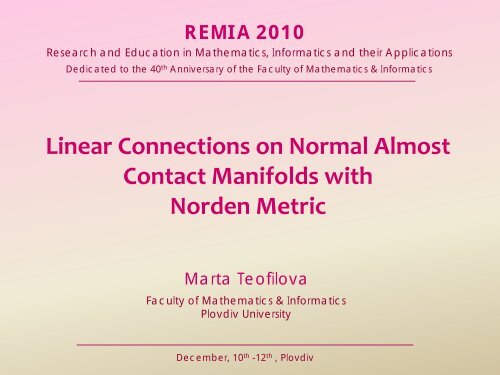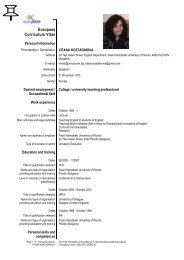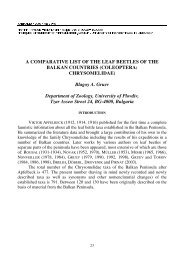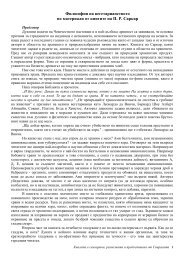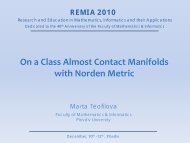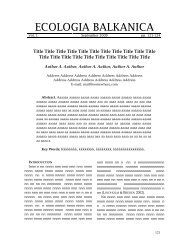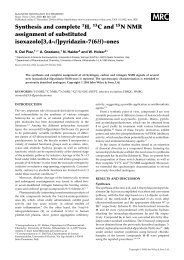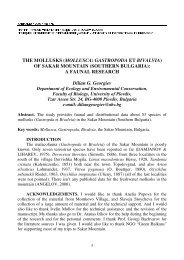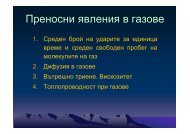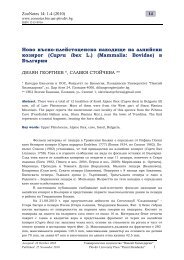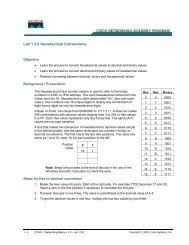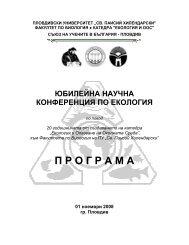Linear Connections on Normal Almost Contact Manifolds with ...
Linear Connections on Normal Almost Contact Manifolds with ...
Linear Connections on Normal Almost Contact Manifolds with ...
You also want an ePaper? Increase the reach of your titles
YUMPU automatically turns print PDFs into web optimized ePapers that Google loves.
REMIA 2010Research and Educati<strong>on</strong> in Mathematics, Informatics and their Applicati<strong>on</strong>sDedicated to the 40 th Anniversary of the Faculty of Mathematics & Informatics<str<strong>on</strong>g>Linear</str<strong>on</strong>g> <str<strong>on</strong>g>C<strong>on</strong>necti<strong>on</strong>s</str<strong>on</strong>g> <strong>on</strong> <strong>Normal</strong> <strong>Almost</strong>C<strong>on</strong>tact <strong>Manifolds</strong> <strong>with</strong>Norden MetricMarta TeofilovaFaculty of Mathematics & InformaticsPlovdiv UniversityDecember, 10 th -12 th , Plovdiv
1. PRELIMINARIESLet (M, ϕ, ξ, η, g) be a (2n + 1)-dimensi<strong>on</strong>al almost c<strong>on</strong>tact manifold<strong>with</strong> Norden metric (B-metric), i.e. (ϕ, ξ, η) is an almostc<strong>on</strong>tact structure, and g is a pseudo-Riemannian metric, called aNorden metric (B-metric) such that [3]ϕ 2 x = −x + η(x)ξ, η(ξ) = 1,g(ϕx, ϕy) = −g(x, y) + η(x)η(y).The associated metric ˜g of g is defined by˜g(x, y) = g(x, ϕy) + η(x)η(y)and is a Norden metric, too. Both metrics are necessarily of signature(n + 1, n).
Let ∇ be the Levi-Civita c<strong>on</strong>necti<strong>on</strong> of g. The fundamental tensor Fis defined byand has the following propertiesF (x, y, z) = g ((∇ x ϕ)y, z)F (x, y, z) = F (x, z, y),F (x, ϕy, ϕz) = F (x, y, z) − F (x, ξ, z)η(y) − F (x, y, ξ)η(z).The following 1-forms are associated <strong>with</strong> F :θ(x) = g ij F (e i , e j , x), θ ∗ (x) = g ij F (e i , ϕe j , x),ω(x) = F (ξ, ξ, x).
A classificati<strong>on</strong> of the almost c<strong>on</strong>tact manifolds <strong>with</strong> Norden metricis introduced in [3]. Eleven basic classes F i (i = 1, 2, ..., 11) arecharacterized there according to the properties of F .The Nijenhuis tensor N of the almost c<strong>on</strong>tact structure (ϕ, ξ, η) isdefined by [5]N(x, y) = ϕ 2 [x, y] + [ϕx, ϕy] − ϕ[ϕx, y] − ϕ[x, ϕy]+ (∇ x η)y.ξ − (∇ y η)x.ξThe almost c<strong>on</strong>tact structure in said to be integrable if N = 0. Inthis case the almost c<strong>on</strong>tact manifold is called normal [5].In terms of the covariant derivatives of ϕ and η the tensor N isexpressed byN(x, y, z) = F (ϕx, y, z) − F (ϕy, x, z) − F (x, y, ϕz)+ F (y, x, ϕz) + F (x, ϕy, ξ)η(z) − F (y, ϕx, ξ)η(z).
The class of the almost c<strong>on</strong>tact manifolds <strong>with</strong> Norden metric satisfyingthe c<strong>on</strong>diti<strong>on</strong>s N = 0, dη = 0 isF 1 ⊕ F 2 ⊕ F 4 ⊕ F 5 ⊕ F 6 [3].Analogously to [2], we define an associated tensorÑ of N byÑ(x, y, z) = F (ϕx, y, z) + F (ϕy, x, z) − F (x, y, ϕz)− F (y, x, ϕz) + F (x, ϕy, ξ)η(z) + F (y, ϕx, ξ)η(z).The class <strong>with</strong> Ñ = 0 and F (ξ, y, z) = 0 is F 3 ⊕ F 7 [3].
The curvature tensor R of ∇ is defined as usually byR(x, y)z = ∇ x ∇ y z − ∇ y ∇ x z − ∇ [x,y] z,and its corresp<strong>on</strong>ding tensor of type (0,4) is given byR(x, y, z, u) = g(R(x, y)z, u).A tensor L of type (0,4) is said to be curvature-like if it has theproperties of R, i.e.L(x, y, z, u) = −L(y, x, z, u) = −L(x, y, u, z),L(x, y, z, u) + L(y, z, x, u) + L(z, x, y, u) = 0.A curvature-like tensor L is called a ϕ-Kähler-type tensor ifL(x, y, ϕz, ϕu) = −L(x, y, z, u).
2. LINEAR CONNECTIONS ON ALMOST CONTACTMANIFOLDS WITH NORDEN METRICLet ∇ ′ be a linear c<strong>on</strong>necti<strong>on</strong> <strong>with</strong> deformati<strong>on</strong> tensor Q, i.e.∇ ′ xy = ∇ x y + Q(x, y).Definiti<strong>on</strong> 2.1. A linear c<strong>on</strong>necti<strong>on</strong> ∇ ′ <strong>on</strong> an almost c<strong>on</strong>tact manifoldis called an almost ϕ-c<strong>on</strong>necti<strong>on</strong> if ϕ is parallel <strong>with</strong> respect to∇ ′ , i.e. if ∇ ′ ϕ = 0.Theorem 2.1. On an almost c<strong>on</strong>tact manifold <strong>with</strong> Norden metricthere exists a 10-parametric family of almost ϕ-c<strong>on</strong>necti<strong>on</strong>s ∇ ′defined byg(∇ ′ xy − ∇ x y, z) = Q(x, y, z)<strong>with</strong> deformati<strong>on</strong> tensor Q given by
Q(x, y, z) = 1 2{F (x, ϕy, z) + F (x, ϕy, ξ)η(z)} − F (x, ϕz, ξ)η(y)+t 1 {F (y, x, z) + F (ϕy, ϕx, z) − F (y, x, ξ)η(z) − F (ϕy, ϕx, ξ)η(z)−F (y, z, ξ)η(x) − F (ξ, x, z)η(y) + η(x)η(y)ω(z)}+t 2 {F (z, x, y) + F (ϕz, ϕx, y) − F (z, x, ξ)η(y) − F (ϕz, ϕx, ξ)η(y)−F (z, y, ξ)η(x) − F (ξ, x, y)η(z) + η(x)η(z)ω(y)}+t 3 {F (y, ϕx, z) − F (ϕy, x, z) − F (y, ϕx, ξ)η(z) + F (ϕy, x, ξ)η(z)−F (y, ϕz, ξ)η(x) − F (ξ, ϕx, z)η(y) + η(x)η(y)ω(ϕz)}+t 4 {F (z, ϕx, y) − F (ϕz, x, y) − F (z, ϕx, ξ)η(y) + F (ϕz, x, ξ)η(y)−F (z, ϕy, ξ)η(x) − F (ξ, ϕx, y)η(z) + η(x)η(z)ω(ϕy)}+t 5 {F (ϕy, z, ξ) + F (y, ϕz, ξ) − η(y)ω(ϕz)}η(x)+t 6 {F (ϕz, y, ξ) + F (z, ϕy, ξ) − ω(ϕy)η(z)}η(x)+t 7 {F (ϕy, ϕz, ξ) − F (y, z, ξ) + η(y)ω(z)}η(x)+t 8 {F (ϕz, ϕy, ξ) − F (z, y, ξ) + ω(y)η(z)}η(x)+t 9 ω(x)η(y)η(z) + t 10 ω(ϕx)η(y)η(z), t i ∈ R, i = 1, 2, ..., 10.
Corollary 2.1. Let (M, ϕ, ξ, η, g) be a F 1 ⊕ F 2 ⊕ F 4 ⊕ F 5 ⊕ F 6 -manifold. Then, the ϕ-c<strong>on</strong>necti<strong>on</strong>s ∇ ′ defined in Theorem 2.1 havethe formg(∇ ′ xy − ∇ x y, z) ==2 1 {F (x, ϕy, z) + F (x, ϕy, ξ)η(z)} − F (x, ϕz, ξ)η(y)+s 1 {F (y, x, z) + F (ϕy, ϕx, z)}(2.1)+s 2 {F (y, ϕx, z) − F (ϕy, x, z)}+s 3 F (y, ϕz, ξ)η(x) + s 4 F (y, z, ξ)η(x),where s 1 = t 1 + t 2 , s 2 = t 3 + t 4 , s 3 = 2(t 5 + t 6 ) − t 3 − t 4 ,s 4 = −t 1 − t 2 − 2(t 7 + t 8 ).
Definiti<strong>on</strong> 2.2. A linear c<strong>on</strong>necti<strong>on</strong> ∇ ′ <strong>on</strong> an almost c<strong>on</strong>tact manifold(M, ϕ, ξ, η) is said to be almost c<strong>on</strong>tact if the almost c<strong>on</strong>tactstructure (ϕ, ξ, η) is parallel <strong>with</strong> respect to it, i.e. if∇ ′ ϕ = ∇ ′ ξ = ∇ ′ η = 0.Propositi<strong>on</strong> 2.2. The almost ϕ-c<strong>on</strong>necti<strong>on</strong>s ∇ ′ defined in Theorem2.1 are almost c<strong>on</strong>tact <strong>on</strong> an almost c<strong>on</strong>tact manifold <strong>with</strong> Nordenmetric and ω = 0.Remark 2.1. The c<strong>on</strong>necti<strong>on</strong>s defined by (2.1) are almost c<strong>on</strong>tact<strong>on</strong> a F 1 ⊕ F 2 ⊕ F 4 ⊕ F 5 ⊕ F 6 -manifold.
Definiti<strong>on</strong> 2.3. A linear c<strong>on</strong>necti<strong>on</strong> ∇ ′ <strong>on</strong> an almost c<strong>on</strong>tact manifold<strong>with</strong> Norden metric (M, ϕ, ξ, η, g) is said to be natural if∇ ′ ϕ = ∇ ′ η = ∇ ′ g = 0.Propositi<strong>on</strong> 2.3. Let (M, ϕ, ξ, η, g) be an almost c<strong>on</strong>tact manifold<strong>with</strong> Norden metric, and let ∇ ′ be the 10-parametric family of almostϕ-c<strong>on</strong>necti<strong>on</strong>s defined in Theorem 2.1. Then(i) ∇ ′ are almost c<strong>on</strong>tact ifft 1 + t 2 − t 9 = t 3 + t 4 − t 10 = 0;(ii) ∇ ′ are natural ifft 1 + t 2 = t 3 + t 4 = t 5 + t 6 = t 7 + t 8 = t 9 = t 10 = 0.
Theorem 2.4. On an almost c<strong>on</strong>tact manifold <strong>with</strong> Norden metricthere exists a 4-parametric family of natural c<strong>on</strong>necti<strong>on</strong>s ∇ ′′ definedbyg(∇ ′′ xy − ∇ x y, z) == 1 2{F (x, ϕy, z) + F (x, ϕy, ξ)η(z)} − F (x, ϕz, ξ)η(y)+p 1 {N(y, z, ϕx) + N(ξ, y, ϕx)η(z) + N(z, ξ, ϕx)η(y)}+p 2 {N(z, y, x) + N(y, ξ, x)η(z) + N(ξ, z, x)η(y)}+p 3 {N(ϕ 2 z, y, ξ) + N(z, ξ, ξ)η(y)}η(x)+p 4 {N(y, ϕz, ξ) + N(ϕz, ξ, ξ)η(y)}η(x),where p 1 = t 1 = −t 2 , p 2 = t 3 = −t 4 , p 3 = t 5 = −t 6 , p 4 = t 7 = −t 8 .
The family ∇ ′′ c<strong>on</strong>sists of a unique natural c<strong>on</strong>necti<strong>on</strong> <strong>on</strong> normalalmost c<strong>on</strong>tact manifolds <strong>with</strong> Norden metric, namely the c<strong>on</strong>necti<strong>on</strong>∇ ′′ xy = ∇ x y + 1 2 {(∇ xϕ)ϕy + (∇ x η)y.ξ} − ∇ x ξ.η(y),which is the well-known can<strong>on</strong>ical c<strong>on</strong>necti<strong>on</strong> [1].
Theorem 2.5. On a F 1 ⊕ F 2 ⊕ F 4 ⊕ F 5 ⊕ F 6 -manifold there existsa symmetric almost c<strong>on</strong>tact c<strong>on</strong>necti<strong>on</strong> ∇ ′ defined by∇ ′ xy = ∇ x y + 1 4{2(∇x ϕ)ϕy + (∇ y ϕ)ϕx − (∇ ϕy ϕ)x+ 2(∇ x η)y.ξ − 3η(x).∇ y ξ − 4η(y).∇ x ξ } .(2.2)Remark 2.2. Let us remark that the c<strong>on</strong>necti<strong>on</strong> ∇ ′ defined by (2.2)can be c<strong>on</strong>sidered as an analogous c<strong>on</strong>necti<strong>on</strong> to the well-known Yanoc<strong>on</strong>necti<strong>on</strong> [6,7] <strong>on</strong> a normal almost c<strong>on</strong>tact manifold <strong>with</strong> Nordenmetric and closed 1-form η.
3. ALMOST CONTACT CONNECTIONS ONF 4 ⊕ F 5 -MANIFOLDSThe classes F 4 and F 5 are defined in [3] by, respectively:F 4 : F (x, y, z) = − θ(ξ)2n{g(ϕx, ϕy)η(z) + g(ϕx, ϕz)η(y)},F 5 : F (x, y, z) = − θ∗ (ξ)2n{g(ϕx, y)η(z) + g(ϕx, z)η(y)}.The subclass of F 4 ⊕ F 5 <strong>with</strong> closed 1-forms θ and θ ∗ is denoted by(F 4 ⊕ F 5 ) 0 .
The almost c<strong>on</strong>tact c<strong>on</strong>necti<strong>on</strong>s ∇ ′ defined by (2.1) have the followingform <strong>on</strong> F 4 ⊕ F 5 -manifolds:∇ ′ xy = ∇ x y + θ(ξ)2n{g(x, ϕy)ξ − η(y)ϕx}+ θ∗ (ξ)2n{g(x, y)ξ − η(y)x}+ λθ(ξ)+µθ∗ (ξ)2n{η(x)y − η(x)η(y)ξ}(2.3)+ µθ(ξ)−λθ∗ (ξ)2nη(x)ϕy,where λ = s 1 + s 4 , µ = s 3 − s 2 .Let us denote by R ′ the curvature tensor of ∇ ′ , i.e. R ′ (x, y)z =∇ ′ x∇ ′ yz − ∇ ′ y∇ ′ xz − ∇ ′ [x,y] z.
Propositi<strong>on</strong> 3.1. Let (M, ϕ, ξ, η, g) be a (F 4 ⊕F 5 ) 0 -manifold, and∇ ′ be 2-parametric family of almost c<strong>on</strong>tact c<strong>on</strong>necti<strong>on</strong>s defined by(2.3). Then, the curvature tensor R ′ of an arbitrary c<strong>on</strong>necti<strong>on</strong> in thefamily (2.3) is of ϕ-Kähler-type and has the formR ′ = R + ξθ(ξ)2n π 5 + ξθ∗ (ξ)2nπ 4 + θ(ξ)24n 2 {π 2 − π 4 }+ θ∗ (ξ) 24n 2 π 1 − θ(ξ)θ∗ (ξ)4n 2 {π 3 − π 5 },where the curvature-like tensors π i (i = 1, 2, 3, 4, 5) are defined by[4]:
π 1 (x, y, z, u) = g(y, z)g(x, u) − g(x, z)g(y, u),π 2 (x, y, z, u) = g(y, ϕz)g(x, ϕu) − g(x, ϕz)g(y, ϕu),π 3 (x, y, z, u) = −g(y, z)g(x, ϕu) + g(x, z)g(y, ϕu)− g(x, u)g(y, ϕz) + g(y, u)g(x, ϕz),π 4 (x, y, z, u) = g(y, z)η(x)η(u) − g(x, z)η(y)η(u)+ g(x, u)η(y)η(z) − g(y, u)η(x)η(z),π 5 (x, y, z, u) = g(y, ϕz)η(x)η(u) − g(x, ϕz)η(y)η(u)+ g(x, ϕu)η(y)η(z) − g(y, ϕu)η(x)η(z).Remark 3.1. Let us remark that the result in Propositi<strong>on</strong> 3.1 isobtained in [4] for the curvature tensor of the can<strong>on</strong>ical c<strong>on</strong>necti<strong>on</strong><strong>on</strong> a (F 4 ⊕ F 5 ) 0 -manifold, i.e. the c<strong>on</strong>necti<strong>on</strong> (2.3) for λ = µ = 0.
REFERENCES[1] V. Alexiev, G. Ganchev, Can<strong>on</strong>ical c<strong>on</strong>necti<strong>on</strong> <strong>on</strong> a c<strong>on</strong>formalalmost c<strong>on</strong>tact metric manifold, Ann. Univ. Sofia-Math. 81 (1987)29–38.[2] G. Ganchev, A. Borisov, Note <strong>on</strong> the almost complex manifolds<strong>with</strong> a Norden metric, Compt. Rend. Acad. Bulg. Sci. 39(5) (1986),31–34.[3] G. Ganchev, V. Mihova, K. Gribachev, <strong>Almost</strong> c<strong>on</strong>tact manifolds<strong>with</strong> B-metric, Math. Balk. N.S. 7(3-4) (1993), 261–276.[4] M. Manev, On the curvature properties of almost c<strong>on</strong>tact B-metric hypersurfaces of Kaehlerian manifolds <strong>with</strong> B-metric, PlovdivUniv. Sci. Works – Math. 33(3) (2001), 61-72.[5] S. Sasaki, <strong>Almost</strong>-c<strong>on</strong>tact manifolds, Lecture Notes Math., Inst.Tôhoko Univ. 1-3, 1965, 1967, 1968.
[6] K. Yano, Affine c<strong>on</strong>necti<strong>on</strong>s in an almost product space, KodaiMath. Semin. Rep. 11(1) (1959), 1–24.[7] K. Yano, Differential geometry <strong>on</strong> complex and almost complexspaces, Pure and Applied Math. vol. 49, Pergam<strong>on</strong> Press Book, NewYork, 1965.


